Diagenesis and Reservoir Properties of the Permian Ecca Group Sandstones and Mudrocks in the Eastern Cape Province, South Africa
Abstract
:1. Introduction
2. Geological Setting
3. Methodology
4. Result
4.1. Diagenesis of Sandstones
4.1.1. Description of Sandstone Diagenesis
Cementation
Compaction
Dissolution
Mineral Replacement
Recrystallization
4.2. Diagenesis of Mudrocks
4.2.1. Description of Mudrock Diagenesis
Physical Compaction
Mineral Replacement
Mineral Compositions
5. Discussion of the Diagenesis of Mudrocks and Sandstones
5.1. Diagenetic Stages
5.1.1. Early Diagenetic Stage
5.1.2. Burial Diagenetic Stage
5.1.3. Uplift-Related Diagenetic Stage
6. Diagenetic Sequence
7. Implications of Diagenesis for Reservoir Properties
8. Conclusions
Acknowledgments
Author Contributions
Conflicts of Interest
References
- Selley, R.C. Elements of Petroleum Geology, 2nd revised ed.; Elsevier Science Publishing Co Inc.: Amsterdam, The Netherlands, 1997; p. 470. [Google Scholar]
- Bjorlykke, K. Diagenesis. In Development in Sedimentology; Chilingarian, G.V., Wolf, K.H., Eds.; Elsevier: Amsterdam, The Netherlands, 1988; Volume 41, pp. 555–588. [Google Scholar]
- Noh, J.; Lee, I. Diagenetic pore fluid evolution in the Pohang Miocene sediments: Oxygen isotopic evidence of septarian carbonate concretions and authigenic mineral phases. Geosci. J. 1999, 3, 141–149. [Google Scholar] [CrossRef]
- Zou, C.; Zhu, R.; Liu, K.; Su, L.; Bai, B.; Zhang, X.; Yuan, X.; Wang, J. Tight gas sandstone reservoirs in China: Characteristics and recognition criteria. J. Pet. Sci. Eng. 2012, 88, 82–91. [Google Scholar] [CrossRef]
- Salem, A.M.; Ketzer, J.M.; Morad, S.; Rizk, R.R.; Al-Aasm, I.S. diagenesis and reservoir-quality evolution of incised-valley sandstones: Evidence from the Abu Madi Gas Reservoirs (Upper Miocene), the Nile Delta Basin, Egypt. J. Sediment. Res. 2005, 75, 572–584. [Google Scholar] [CrossRef]
- Honarmand, J.; Amini, A. Diagenetic processes and reservoir properties in the ooid grainstones of the Asmari Formation, Cheshmeh Khush Oil Field, SW Iran. J. Pet. Sci. Eng. 2012, 81, 70–79. [Google Scholar] [CrossRef]
- Boggs, S.J. Petrology of Sedimentary Rocks, 2nd ed.; Cambridge University Press: Cambridge, UK, 2009; p. 600. [Google Scholar]
- Burley, S.D.; Worden, R.H. Sandstone. In Sandstone Diagenesis; Recent and, Ancient, Burley, S.D., Worden, R.H., Eds.; Blackwell Publishing: Malden, MA, USA, 2003; Volume 4, pp. 3–44. [Google Scholar]
- Tucker, M.E. Sedimentary Petrology, 3rd ed.; Blackwell Publishing Company: Oxford, UK, 2001; p. 262. [Google Scholar]
- Curtis, C. Sedimentary geochemistry: environments and processes dominated by involvement of an aqueous phase. Philos. Trans. R. Soc. 1977, 286, 272–353. [Google Scholar] [CrossRef]
- Giles, M.R.; Marshall, J.D. Constraints on the development of secondary porosity in the subsurface: Re-evaluation of processes. Mar. Pet. Geol. 1986, 3, 243–255. [Google Scholar] [CrossRef]
- Wright, V.P. Sedimentology Review 1; Blackwell Publishing: Oxford, UK, 1993; p. 152. [Google Scholar]
- Bloch, S.; Lander, R.H.; Bonell, L. Anomalously high porosity and permeability in deeply buried sandstones reservoirs. Origin and predictability. Am. Assoc. Pet. Geol. Bull. 2002, 86, 301–328. [Google Scholar]
- Mackenzie, F.T. Diagenesis, and sedimentary rocks. In Treatise on Geochemistry, 2nd ed.; Elsevier: Oxford, UK, 2005; p. 446. [Google Scholar]
- Milliken, K.L. Understanding Diagenetic Controls of Sandstone Reservoir Quality: A Compendium of Influential Papers. Available online: http://store.aapg.org/detail.aspx?id=878 (accessed on 13 October 2016).
- Ajdukiewicz, J.M.; Lander, R.H. Sandstone reservoir quality prediction: The state of the art. Am. Assoc. Pet. Geol. Bull. 2010, 94, 1083–1091. [Google Scholar] [CrossRef]
- Roswell, D.M.; de Swart, A.M.J. Diagenesis in Cape and Karroo sediments, South Africa, and its bearing on their hydrocarbon potential. Trans. Geol. Soc. S. Afr. 1976, 79, 81–145. [Google Scholar]
- Reed, J.S.; Eriksson, K.A.; Kowalewski, M. Climatic, depositional and burial controls on diagenesis of Appalachian Carboniferous sandstones: qualitative and quantitative methods. Sediment. Geol. 2005, 176, 225–246. [Google Scholar] [CrossRef]
- Geel, C.; Schulz, H.M.; Booth, P.; de Wit, M.; Horsfield, B. Shale gas characteristics of Permian black shales in South Africa: Results from recent drilling in the Ecca Group (Eastern Cape). Energy Procedia 2013, 40, 256–265. [Google Scholar] [CrossRef]
- Macquaker, J.H.S.; Taylor, K.G.; Keller, M.; Polya, D. Compositional controls on early diagenetic pathways in fine-grained sedimentary rocks: Implications for predicting unconventional reservoir attributes of mudstones. Am. Assoc. Pet. Geol. Bull. 2014, 93, 587–603. [Google Scholar] [CrossRef]
- Molenaar, N. Origin of low-permeability calcite-cemented lenses in shallow marine sandstones and CaCO3 cementation mechanisms, an example from the Lower Jurassic Luxemburg sandstones, Luxemburg. In Carbonate Cementation of Sandstones; Blackwell Publishing Ltd.: Oxford, UK, 1998. [Google Scholar]
- Johnson, M.R.; Van Vuuren, C.J.; Visser, J.N.J.; Cole, D.I.; de V. Wickens, H.; Christie, A.D.M.; Roberts, D.L.; Brandl, G. Sedimentary rocks of the Karoo Supergroup. In The Geology of South Africa; Johnson, M.R., Anhaeusser, C.R., Thomas, R.J., Eds.; The Geological Society of South Africa: Johannesburg, South Africa, 2006; pp. 461–499. [Google Scholar]
- Fildani, A.; Drinkwater, N.J.; Weislogel, A.; McHargue, T.; Hodgson, D.; Flint, S. Age controls of the Tanqua and Laingsburg deep-water systems: new insights on the evolution and sedimentary fill of the Karoo basin, South Africa. J. Sediment. Res. 2007, 77, 901–908. [Google Scholar] [CrossRef]
- Smith, R.M.H. A review of the stratigraphy and sedimentary environments of the Karoo basin of South Africa. J. Afr. Earth Sci. 1990, 10, 117–137. [Google Scholar] [CrossRef]
- Johnson, M.R.; van Vuuren, C.J.; Hegenberger, W.F.; Key, R.; Shoko, U. Stratigraphy of the Karoo Supergroup in southern Africa: An overview. J. Afr. Earth Sci. 1996, 23, 3–15. [Google Scholar] [CrossRef]
- Catuneanu, O.; Hancox, P.J.; Rubidge, B.S. Reciprocal flexural behaviour and contrasting stratigraphies: A new basin development model for the Karoo retro-arc foreland system, South Africa. Basin Res. 1998, 10, 417–439. [Google Scholar] [CrossRef]
- Johnson, M.R. Stratigraphy and Sedimentology of the Cape and Karoo Sequences in the Eastern Cape Province. Ph.D. Thesis, Rhodes University, Grahamstown, South Africa, 1976. [Google Scholar]
- Cole, D.I. Evolution and development of the Karoo Basin. In Inversion Tectonics of the Cape Fold Belt, Karoo and Cretaceous Basins of Southern Africa; de Wit, M.J., Ransome, I.D.G., Eds.; Balkema: Rotterdam, The Netherlands, 1992; pp. 87–99. [Google Scholar]
- Branch, T.; Ritter, O.; Weckmann, U.; Sachsenhofer, R.; Schilling, F. The Whitehill Formation—A high conductivity marker horizon in the Karoo Basin. S. Afr. J. Geol. 2007, 110, 465–476. [Google Scholar] [CrossRef]
- Decker, J.; Marot, J. Investigation of Hydraulic Fracturing in the Karoo of South Africa. Annexure A, Resource Assessment, Petroleum Agency SA, 2012. Available online: http://www.dmr.gov.za/publications/viewdownload/182/854.html (accessed on 15 March 2015).
- Advance Resource International. Shale gas and oil assessment in Karoo Basin, South Africa. In EIA/ARI World Shale Gas and Shale Oil Resource Assessment; United States Energy Information Administration: Washington, DC, USA, 2013; p. 14. [Google Scholar]
- Econometrix. Karoo Shale Gas Report: Special Considerations Surrounding Potential Shale Gas Resources in the Southern Karoo of South Africa. Available online: http://www-tatic.shell.com/static/zaf/downloads/aboutshell/econometrix/econometrix_report.pdf (accessed on 8 September 2013).
- Kuuskraa, V.; Stevens, S.; van Leeuwen, T.; Moodhe, K. World Shale Gas Resources: An Initial Assessment Prepared for United States Energy Information Administration. World Shale Gas Resources: An Initial Assessment of 14 Regions Outside the United States. Available online: http://www.eia.doe.gov/analysis/studies/worldshalegas (accessed on 15 April 2015).
- Dickinson, W.R.; Suczek, C. Plate tectonics and sandstone composition. Am. Assoc. Pet. Geol. Bull. 1979, 63, 2164–2194. [Google Scholar]
- Dickinson, W.R.; Beard, S.; Brakenbridge, F.; Erjavec, J.; Fergusion, R.; Inman, K.; Knepp, R.; Linberg, P.; Ryberg, P. Provenance of the North American Phanerozoic sandstones in relation to tectonic setting. Geol. Soc. Am. Bull. 1983, 64, 222–235. [Google Scholar] [CrossRef]
- Hurst, A.; Irwin, H. Geological Modelling of Clay Diagenesis in Sandstones. Clay Miner. 1982, 17, 5–22. [Google Scholar] [CrossRef]
- Pallastro, R.M. Mineralogical and morphological evidence for formation of illite at the expense of illite/smectite. Clays Clay Miner. 1985, 33, 265–274. [Google Scholar] [CrossRef]
- Chapelle, F.H. Ground-Water Microbiology and Geochemistry; John Wiley and Sons: New York, NY, USA, 1993; p. 448. [Google Scholar]
- Lewin, J.C. The dissolution of Silica from Diatom walls. Geochim. Cosmochim. Acta 1971, 21, 182–198. [Google Scholar] [CrossRef]
- Schmidt, V.; McDonald, D.A. Texture and recognition of secondary porosity in sandstones. In Aspects of Diagenesis Peter; Schluger, P.R., Ed.; Society of Economic Paleontologists and Mineralogists: Tulsa, OK, USA, 1979; Volume 26, pp. 209–225. [Google Scholar]
- Schmidt, V.; McDonald, O.A. The role of secondary porosity in the course of sandstone diagenesis. In Aspects of Diagenesis; Scholle, P.A., Schluger, P.R., Eds.; Society of Economic Paleontologists and Mineralogists: Tulsa, OK, USA, 1979; Volume 26, pp. 175–207. [Google Scholar]
- Walker, T.R. Formation of red beds in modern and ancient deserts. Geol. Soc. Am. Bull. 1967, 78, 353–368. [Google Scholar] [CrossRef]
- Harder, H. Synthesis of glauconite at surface temperatures. Clays Clay Miner. 1980, 28, 217–222. [Google Scholar] [CrossRef]
- Boggs, S.J. Principles of Sedimentology and Stratigraphy, 4th ed.; Prentice Hall: Upper Saddle River, NJ, USA, 2006; p. 774. [Google Scholar]
- Clayton, C.J. Microbial and organic processes. In Quantitative Diagenesis: Recent Developments and Applications to Reservoir Geology; Parler, A., Sellwood, B.W., Eds.; Kluwer: Dordrecht, The Netherlands, 1994; pp. 125–160. [Google Scholar]
- Dapples, E.C. Diagenesis of sandstones. In Developments in Sedimentology; Elsevier: Amsterdam, The Netherlands, 1967; Volume 8, pp. 91–125. [Google Scholar]
- Bjorlykke, K.; Elverhoi, A.; Malm, O. Diagenesis in Mesozoic Sandstones from Spitzbergen and the North Sea—A comparison. Geol. Rundsch. J. 1979, 68, 1152–1171. [Google Scholar] [CrossRef]
- Bruner, K.R.; Smosna, R. A Comparative Study of the Mississippian Barnett Shale, Fort Worth Basin and Devonian Marcellus Shale, Appalachian Basin; U.S. Department Energy, National Energy Technology Laboratory: Pittsburgh, PA, USA, 2011; p. 106.
- Montgomery, S.L.; Jarvie, D.M.; Bowker, K.A.; Pollastro, R.M. Mississippian Barnett Shale, Fort Worth Basin, North-Central Texas: Gas-shale play with multi-trillion cubic foot potential. Am. Assoc. Pet. Geol. Bull. 2005, 89, 155–175. [Google Scholar] [CrossRef]
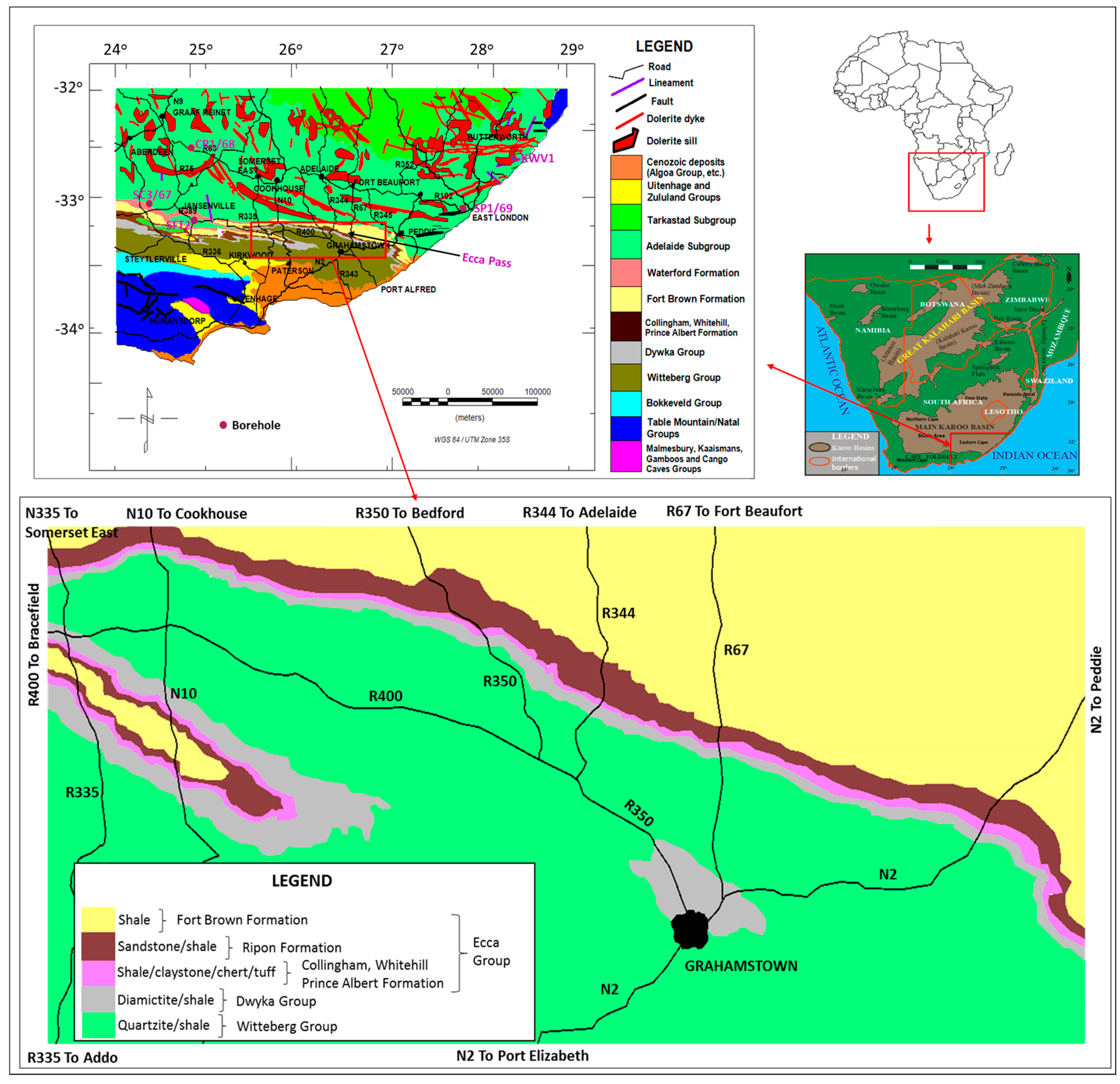


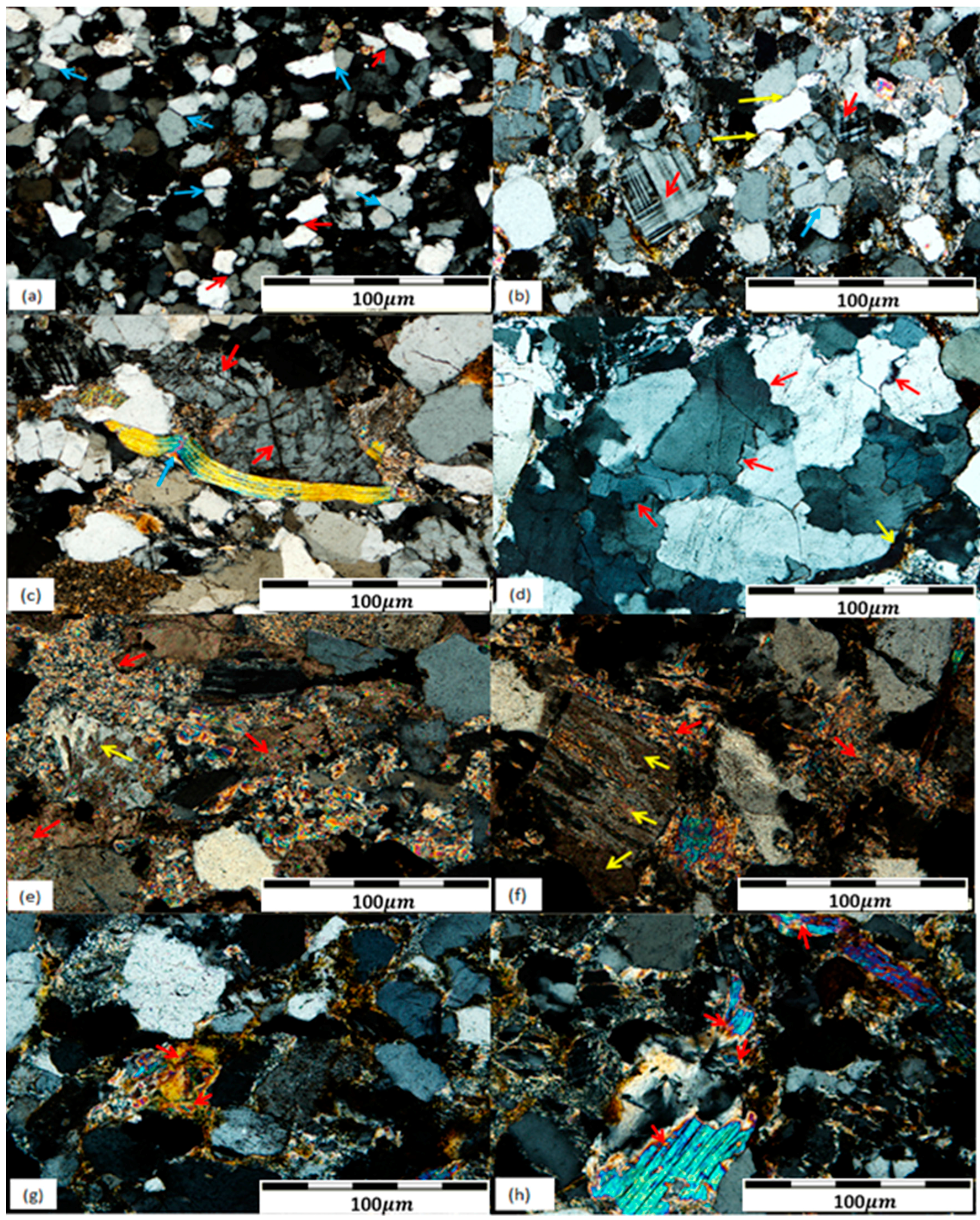

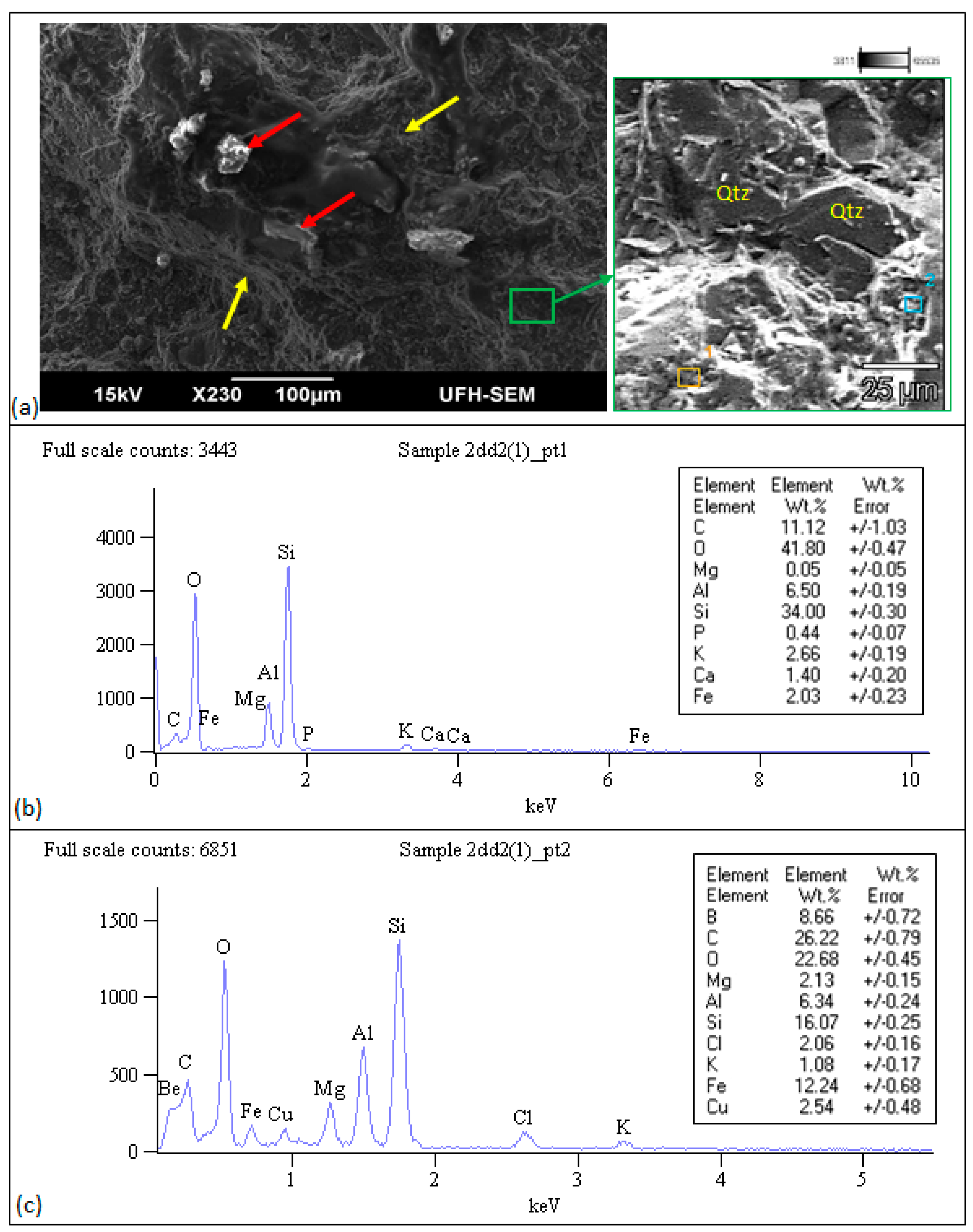

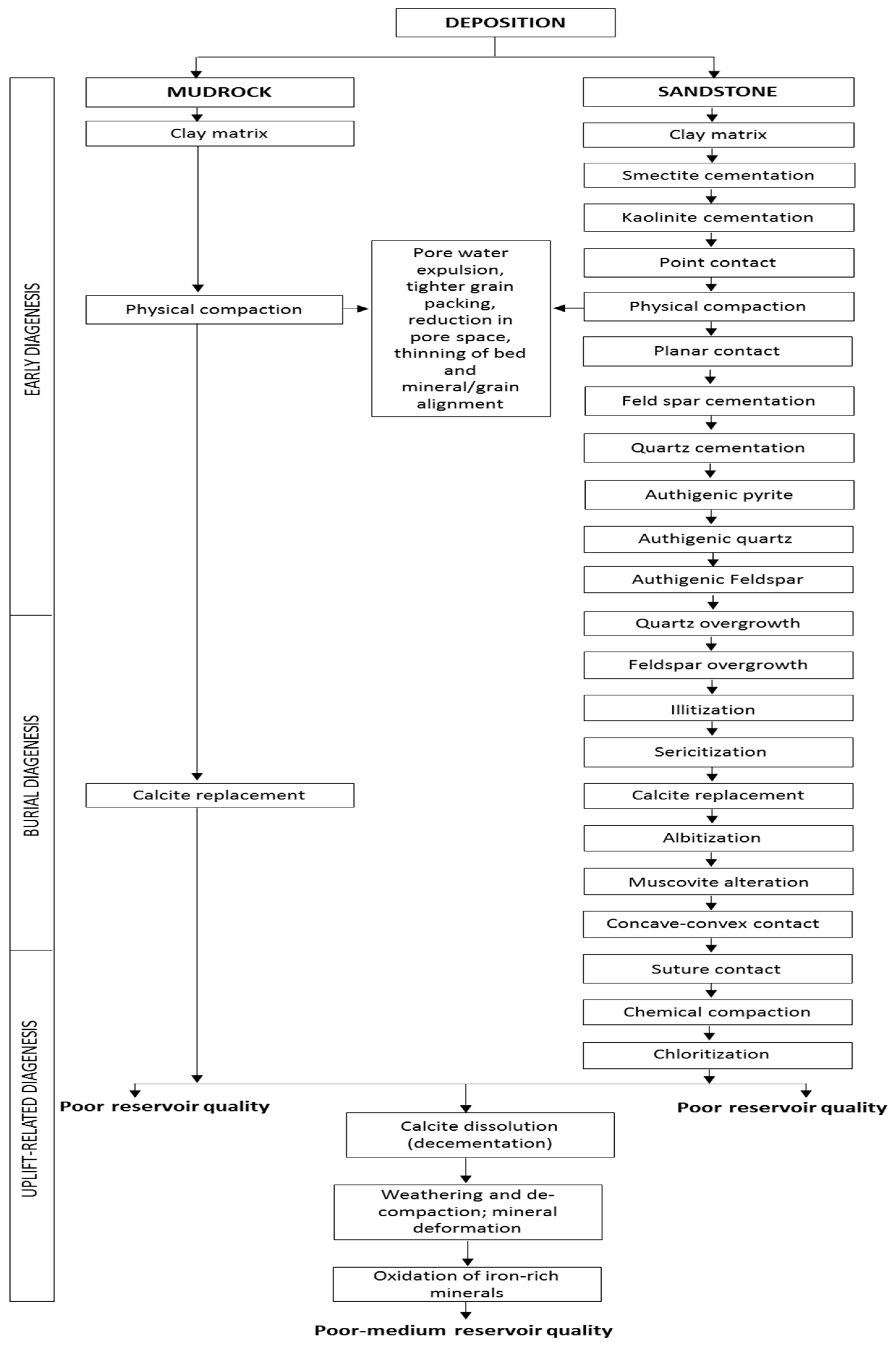
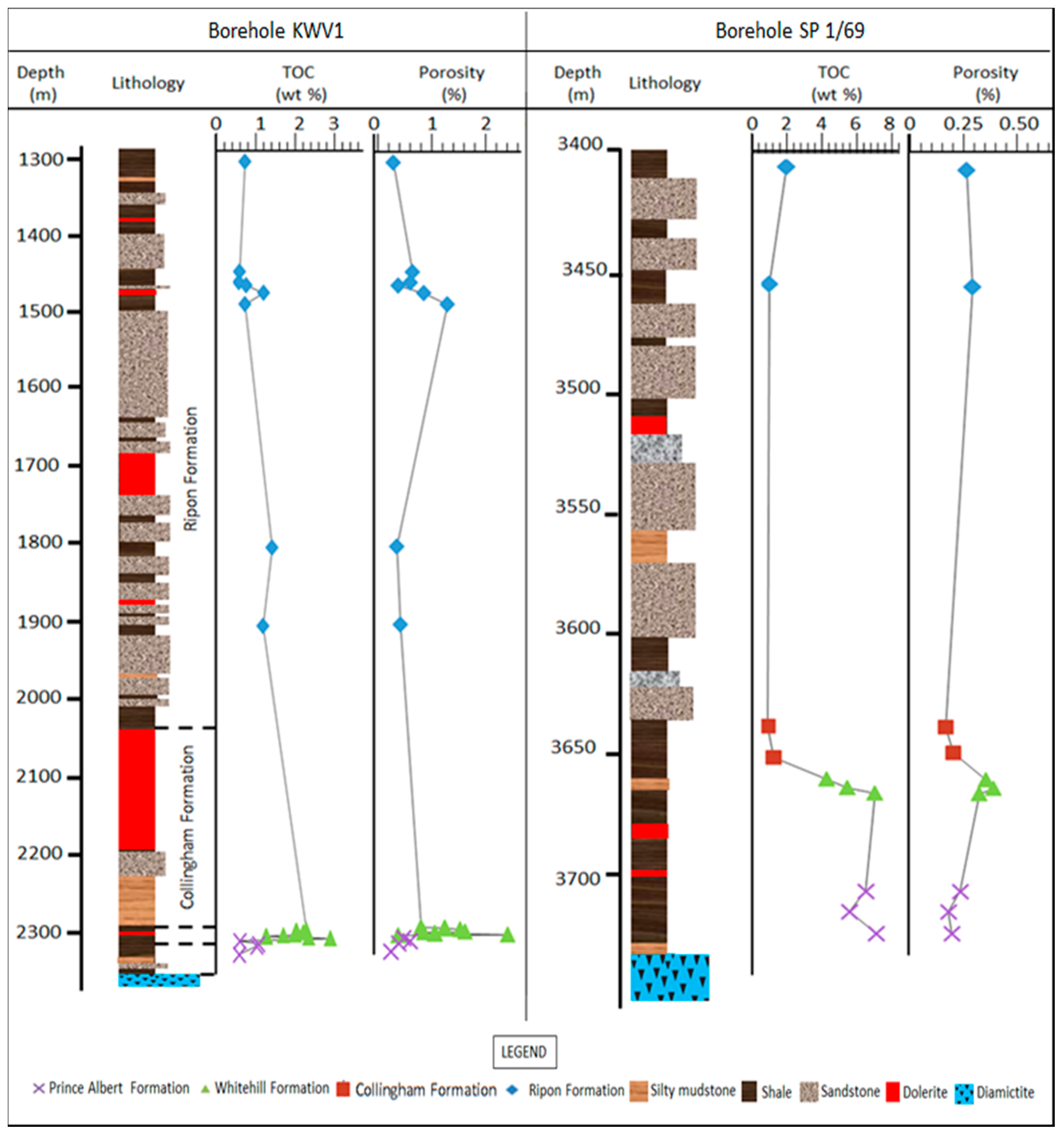
| Supergroup | Group | Formation | Lithology | Max. Thickness (m) |
|---|---|---|---|---|
| Karoo | Beaufort | Koonap | Grey Sandstone Shale | 1300 |
| Ecca | Waterford (Not present in Ecca Pass) | Sandstone Shale | 800 | |
| Fort Brown | Shale Sandstone | 1500 | ||
| Ripon | Sandstone Shale | 1000 | ||
| Collingham | Grey Shale Yellow Claystone | 30 | ||
| Whitehill | Black Shale Chert | 70 | ||
| Prince Albert | Khaki Shale | 120 | ||
| Dwyka | Dwyka | Diamictite, Tillite, Shale | 750 |
| SAMPLE | Qt (%) | Qm (%) | Qp (%) | F (%) | L (%) | Lt (%) | Mx (%) | Acc (%) | Normalized (100%) | |||||
|---|---|---|---|---|---|---|---|---|---|---|---|---|---|---|
| Qm-F-Lt (%) | Qt-F-L (%) | |||||||||||||
| Qm | F | Lt | Qt | F | L | |||||||||
| FB 6 | 27.4 | 21.6 | 5.8 | 32.0 | 17.6 | 23.4 | 18.6 | 4.4 | 28.05 | 41.6 | 30.4 | 35.6 | 41.6 | 22.9 |
| FB 5 | 24.2 | 20.6 | 3.6 | 34.4 | 18.6 | 22.2 | 20.2 | 2.6 | 26.7 | 44.6 | 28.8 | 31.4 | 44.6 | 24.1 |
| FB 4 | 31.8 | 27.8 | 4.0 | 26.4 | 20.4 | 24.4 | 17.2 | 4.2 | 35.4 | 33.6 | 31.0 | 40.5 | 33.6 | 26.0 |
| FB 3 | 29.2 | 27.4 | 1.8 | 26.2 | 29.2 | 31.0 | 13.6 | 1.8 | 32.4 | 30.8 | 36.6 | 34.5 | 31.0 | 34.5 |
| FB 2 | 30.6 | 26.2 | 4.4 | 26.2 | 16.8 | 21.2 | 21.4 | 5.0 | 35.6 | 35.6 | 28.8 | 41.6 | 35.6 | 22.8 |
| FB 1 | 28.4 | 23.8 | 4.6 | 32.8 | 14.8 | 19.4 | 20.8 | 3.2 | 31.3 | 43.1 | 25.5 | 37.4 | 43.2 | 19.5 |
| RP 19 | 18.6 | 15.8 | 2.8 | 17.2 | 26.2 | 29.0 | 31.2 | 6.8 | 25.5 | 27.7 | 46.8 | 30 | 27.7 | 42.3 |
| RP 18 | 17.8 | 15.2 | 2.6 | 12.8 | 18.2 | 20.8 | 33.6 | 17.6 | 31.1 | 26.2 | 42.6 | 36.5 | 26.2 | 37.3 |
| RP 17 | 23.0 | 19 | 4.0 | 20.6 | 29.6 | 33.6 | 23.4 | 3.4 | 26.0 | 28.1 | 45.9 | 31.4 | 28.1 | 40.4 |
| RP 16 | 23.0 | 14.2 | 8.8 | 20.8 | 24.0 | 32.8 | 25.6 | 6.6 | 20.9 | 30.7 | 48.4 | 33.9 | 30.7 | 35.4 |
| RP 15 | 21.4 | 20.2 | 1.2 | 23.2 | 16.6 | 17.8 | 34.0 | 4.8 | 33.0 | 37.9 | 29.1 | 35.0 | 37.9 | 27.1 |
| RP 14 | 24.4 | 20.0 | 4.4 | 18.4 | 26.4 | 30.8 | 24.8 | 6.0 | 28.9 | 26.6 | 44.5 | 35.3 | 26.6 | 38.2 |
| RP 13 | 27.2 | 20.4 | 6.8 | 19.2 | 18.6 | 25.4 | 30.4 | 4.6 | 31.4 | 29.5 | 39.0 | 41.9 | 29.5 | 28.6 |
| RP 12 | 30.0 | 25.4 | 4.6 | 16.8 | 20.8 | 25.4 | 26.8 | 5.6 | 37.6 | 24.9 | 37.6 | 44.4 | 24.9 | 30.8 |
| RP 11 | 24.8 | 21.6 | 3.2 | 17.2 | 23.2 | 26.4 | 32.4 | 2.4 | 33.1 | 26.4 | 40.5 | 38.0 | 26.4 | 35.6 |
| RP 10 | 21.6 | 15.6 | 6.0 | 16.4 | 25.4 | 31.4 | 32.2 | 4.4 | 24.6 | 26.0 | 49.5 | 34.1 | 25.9 | 40.1 |
| RP 9 | 20.8 | 15.2 | 5.6 | 11.4 | 17.2 | 22.8 | 42.2 | 8.4 | 30.8 | 23.1 | 46.2 | 42.1 | 23.1 | 34.8 |
| RP 8 | 19.6 | 15.0 | 4.6 | 14.8 | 29.6 | 34.2 | 34.0 | 2.0 | 23.4 | 23.1 | 53.4 | 30.6 | 23.1 | 46.3 |
| RP 7 | 25.6 | 17.6 | 8.0 | 23.0 | 31.6 | 39.6 | 16.8 | 3.0 | 21.9 | 28.7 | 49.4 | 31.9 | 28.7 | 39.4 |
| RP 6 | 18.4 | 11.2 | 7.2 | 20.0 | 22.4 | 29.6 | 32.4 | 6.8 | 18.4 | 32.9 | 48.7 | 30.3 | 32.9 | 36.8 |
| RP 5 | 27.4 | 22.0 | 5.4 | 21.2 | 32.0 | 37.4 | 17.2 | 2.2 | 27.3 | 26.3 | 46.4 | 34 | 26.3 | 39.7 |
| RP 4 | 29.0 | 25.0 | 4.0 | 20.6 | 25.6 | 29.6 | 21.4 | 3.4 | 33.2 | 27.4 | 39.4 | 38.6 | 27.4 | 34.0 |
| RP 3 | 23.0 | 18.2 | 4.8 | 11.8 | 20 | 24.8 | 41.2 | 4.0 | 33.2 | 21.5 | 45.3 | 42.0 | 21.5 | 36.5 |
| RP 2 | 30.2 | 23.8 | 6.4 | 23.2 | 24.8 | 31.2 | 16.2 | 5.6 | 30.4 | 29.7 | 39.9 | 38.6 | 29.7 | 31.7 |
| RP 1 | 26.8 | 21.8 | 5.0 | 19 | 16.4 | 21.4 | 30.6 | 7.2 | 35.0 | 30.6 | 34.4 | 43.1 | 30.6 | 26.4 |
| CH 5 | 31.6 | 26.4 | 5.2 | 16.8 | 19.6 | 24.8 | 25.6 | 6.4 | 38.8 | 24.7 | 36.5 | 46.5 | 24.7 | 28.8 |
| CH 4 | 24.6 | 19.2 | 5.4 | 19 | 17.8 | 23.2 | 35.2 | 3.4 | 31.2 | 30.9 | 37.8 | 40.1 | 30.9 | 29.0 |
| CH 3 | 28.6 | 26.2 | 2.4 | 20.4 | 18.0 | 20.4 | 28.4 | 4.6 | 39.1 | 30.5 | 30.5 | 42.7 | 30.5 | 269 |
| CH 2 | 30.4 | 24.8 | 5.6 | 15.8 | 21.4 | 27.0 | 20.8 | 11.6 | 36.7 | 23.4 | 39.9 | 45.0 | 23.4 | 31.7 |
| CH 1 | 27.8 | 21.2 | 6.6 | 12.8 | 20.6 | 27.2 | 32.0 | 6.8 | 34.6 | 20.9 | 44.4 | 45.4 | 20.9 | 33.7 |
| PA 5 | 19.4 | 15.8 | 3.6 | 10.8 | 18 | 21.6 | 42.6 | 9.2 | 32.8 | 22.4 | 44.8 | 40.3 | 22.4 | 37.3 |
| PA 4 | 23.2 | 20.4 | 2.8 | 13.8 | 18.6 | 21.4 | 34.0 | 10.4 | 36.7 | 24.8 | 38.5 | 41.7 | 24.8 | 33.5 |
| PA 3 | 20.4 | 16.8 | 3.6 | 10.6 | 21.0 | 24.6 | 42.2 | 5.8 | 32.3 | 20.4 | 47.3 | 39.2 | 20.4 | 40.4 |
| PA 2 | 23.8 | 19.2 | 4.6 | 12.8 | 16.0 | 20.6 | 35.0 | 12.4 | 36.5 | 24.3 | 39.2 | 45.3 | 24.3 | 30.4 |
| PA 1 | 18.4 | 17.2 | 1.2 | 15.6 | 17.0 | 18.2 | 41.2 | 7.8 | 33.7 | 30.6 | 35.7 | 36.1 | 30.6 | 33.3 |
| Formation | Sample ID | Plagioclase (%) | Microcline (%) | Quartz (%) | Illite (%) | Chlorite (%) | Mica (%) | Smectite (%) | Talc/pyrophyllite (%) | Sericite (%) | Hematite (%) | Pyrite (%) | Dolomite (%) | Garnet (%) | Zircon (%) | Zeolite (%) |
|---|---|---|---|---|---|---|---|---|---|---|---|---|---|---|---|---|
| Fort Brown | Sandstone | 26 | 1 | 31 | 4 | 4 | 1 | 24 | 8 | - | tc | - | - | tc | tc | tc |
| Fort Brown | Sandstone | 30 | 2 | 29 | 6 | 5 | 2 | 20 | 5 | - | tc | - | - | tc | tc | tc |
| Fort Brown | Mudstone | 28 | 2 | 30 | 6 | 6 | 2 | 18 | 7 | - | tc | - | - | tc | tc | tc |
| Ripon | Sandstone | 20 | 3 | 38 | 7 | 3 | 5 | 17 | 6 | - | - | - | - | - | tc | tc |
| Ripon | Sandstone | 16 | tc | 21 | 30 | 10 | 8 | 12 | 2 | - | - | tc | - | tc | tc | tc |
| Ripon | Sandstone | 17 | tc | 18 | 28 | 9 | 6 | 18 | 3 | - | - | - | - | tc | - | - |
| Ripon | Sandstone | 12 | tc | 25 | 26 | 11 | 4 | 20 | 1 | - | - | - | - | tc | - | tc |
| Ripon | Sandstone | 10 | 2 | 32 | 25 | 14 | 17 | tc | - | - | - | - | - | - | - | - |
| Ripon | Sandstone | 10 | tc | 36 | 18 | 9 | 26 | - | - | - | - | - | - | tc | - | - |
| Ripon | Mudstone | 20 | - | 27 | 6 | 11 | tc | 35 | tc | - | tc | tc | - | tc | tc | - |
| Ripon | Shale | 19 | tc | 16 | 26 | 9 | 8 | 16 | 5 | - | - | - | - | tc | - | - |
| Ripon | Shale | 28 | 4 | 40 | 7 | 3 | 5 | 2 | 11 | - | - | - | - | - | - | - |
| Ripon | Sandstone | 25 | tc | 30 | 6 | 4 | 6 | 28 | - | tc | tc | - | - | - | - | - |
| Ripon | Sandstone | 18 | 3 | 34 | 6 | 1 | 9 | 23 | 5 | - | - | - | - | - | tc | tc |
| Ripon | Mudstone | 25 | tc | 32 | 5 | 8 | 2 | 25 | 2 | tc | tc | tc | - | tc | tc | tc |
| Ripon | Mudstone | 19 | - | 28 | 7 | 10 | 1 | 34 | tc | - | tc | tc | - | tc | tc | - |
| Ripon | Mudstone | 23 | 3 | 34 | 7 | 6 | 11 | 13 | tc | 2 | - | - | - | tc | - | - |
| Collingham | Shale | 12 | 4 | 32 | 13 | 10 | 5 | 23 | - | - | - | tc | - | tc | tc | - |
| Collingham | Shale | 13 | - | 30 | 11 | 13 | 4 | 28 | - | - | - | tc | - | tc | - | - |
| Collingham | Shale | 11 | - | 40 | 12 | 8 | 16 | 12 | - | - | - | - | - | tc | tc | - |
| Whitehill | Shale | 23 | - | 37 | 9 | 6 | 14 | 8 | - | tc | - | 2 | - | - | - | - |
| Whitehill | Shale | 9 | - | 28 | 14 | 4 | 18 | 12 | - | - | - | 9 | 6 | - | - | - |
| Whitehill | Shale | 12 | - | 32 | 26 | - | 2 | tc | - | tc | - | 5 | 22 | - | - | - |
| Whitehill | Shale | 7 | tc | 30 | 16 | 8 | 15 | 6 | - | tc | tc | 7 | 9 | - | - | - |
| Prince Albert | Mudstone | 10 | 2 | 25 | 18 | 6 | 3 | 30 | - | 5 | tc | tc | - | tc | tc | - |
| Prince Albert | Mudstone | 15 | tc | 20 | 14 | 8 | 4 | 31 | - | 7 | tc | tc | - | tc | tc | - |
| Prince Albert | Mudstone | 13 | tc | 23 | 16 | 4 | 6 | 33 | - | 3 | tc | tc | - | tc | tc | - |
 |
| Formation | Lithology | Average Thickness (m) | Average Density (kg/m3) | Average Porosity (%) |
|---|---|---|---|---|
| Fort Brown | Sandstone | 892 | 2.774 | 2.444 |
| Shale | 2.656 | 1.574 | ||
| Ripon | Sandstone | 700 | 2.721 | 3.241 |
| Shale | 2.662 | 1.595 | ||
| Collingham | Shale | 65 | 2.598 | 1.188 |
| Whitehill | Shale | 21 | 2.526 | 2.710 |
| Prince Albert | Shale | 87 | 2.641 | 1.260 |
© 2017 by the authors. Licensee MDPI, Basel, Switzerland. This article is an open access article distributed under the terms and conditions of the Creative Commons Attribution (CC BY) license (http://creativecommons.org/licenses/by/4.0/).
Share and Cite
Baiyegunhi, C.; Liu, K.; Gwavava, O. Diagenesis and Reservoir Properties of the Permian Ecca Group Sandstones and Mudrocks in the Eastern Cape Province, South Africa. Minerals 2017, 7, 88. https://doi.org/10.3390/min7060088
Baiyegunhi C, Liu K, Gwavava O. Diagenesis and Reservoir Properties of the Permian Ecca Group Sandstones and Mudrocks in the Eastern Cape Province, South Africa. Minerals. 2017; 7(6):88. https://doi.org/10.3390/min7060088
Chicago/Turabian StyleBaiyegunhi, Christopher, Kuiwu Liu, and Oswald Gwavava. 2017. "Diagenesis and Reservoir Properties of the Permian Ecca Group Sandstones and Mudrocks in the Eastern Cape Province, South Africa" Minerals 7, no. 6: 88. https://doi.org/10.3390/min7060088





